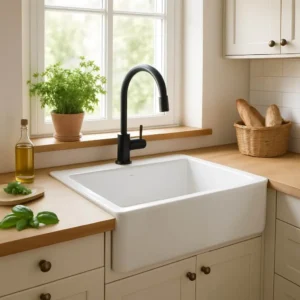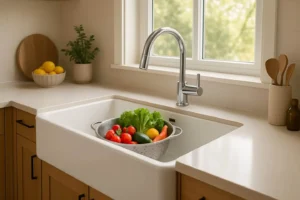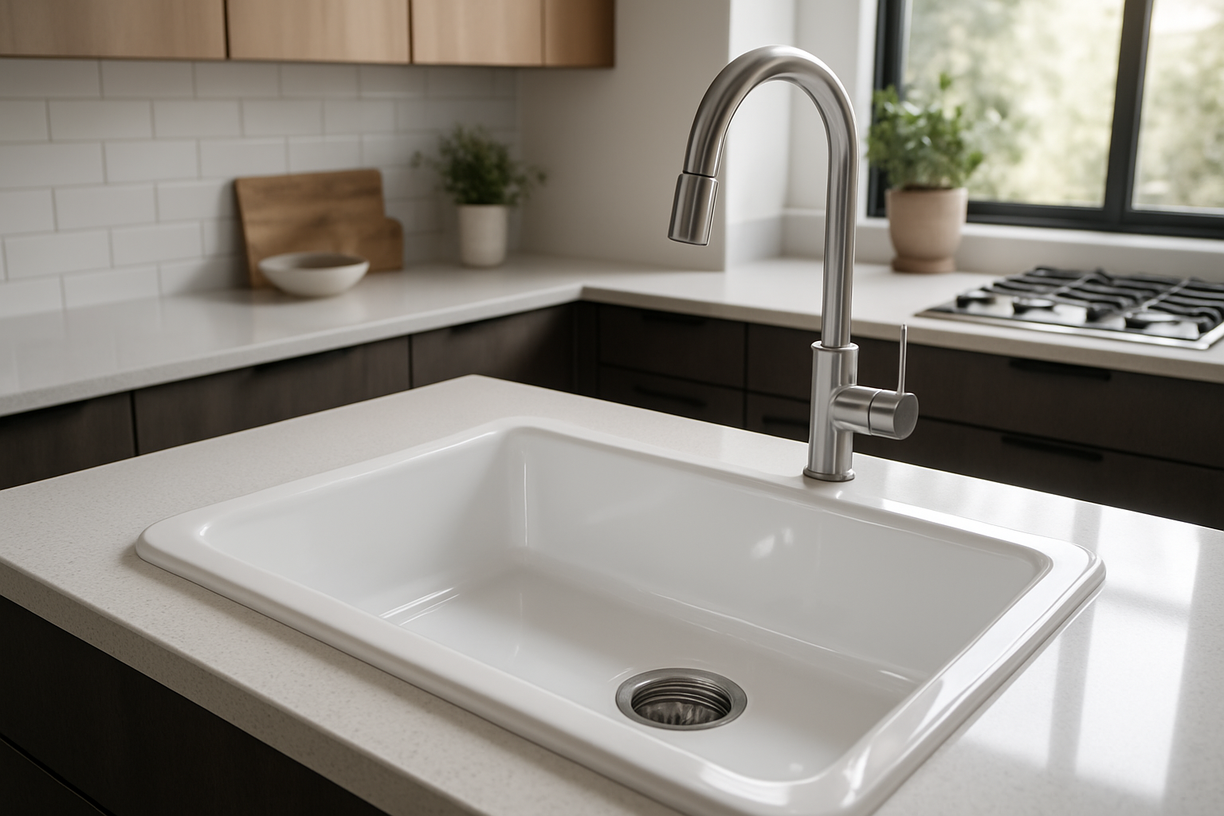Kitchen renovations can quickly become overwhelming when you realize that choosing the wrong sink could mean dealing with chips, stains, and constant maintenance headaches for years to come. With so many materials and styles available, homeowners often struggle to find the perfect balance between durability, aesthetics, and practicality.
That’s where ceramic kitchen sinks shine. These timeless fixtures offer exceptional resistance to cracks and stains while maintaining their elegant appearance through decades of daily use. Unlike trendy materials that may look outdated in a few years, ceramic sinks provide a classic foundation that adapts to both traditional and modern kitchen designs.
This comprehensive guide breaks down everything you need to know about selecting, installing, and maintaining the best ceramic kitchen sink for your home. From understanding different ceramic types to comparing installation methods, we’ll help you make an informed decision that enhances both your kitchen’s functionality and long-term value.


Understanding Ceramic Kitchen Sinks – Materials and Manufacturing Excellence
When you’re shopping for a new kitchen sink, understanding what goes into making a ceramic kitchen sink can help you make the right choice. These sinks aren’t just pretty faces – they’re built to last through years of daily use, spills, and scrubbing.
The secret behind a quality ceramic kitchen sink lies in its composition and how it’s made. Clay forms the foundation, but not just any clay will do. Manufacturers select specific clay types rich in kaolin and other minerals that can withstand extreme temperatures without cracking or warping.
“The firing process transforms ordinary clay into a durable, non-porous surface that resists stains and bacteria, making ceramic kitchen sinks both practical and hygienic for everyday use.”
What Makes Ceramic Kitchen Sinks Different: Clay Composition and Firing Process
The magic happens in the kiln. Raw clay gets shaped into sink forms and then fired at temperatures reaching 2,200 degrees Fahrenheit. This intense heat creates a chemical transformation called vitrification, where clay particles fuse together to form a glass-like surface.
During firing, the clay shrinks and hardens significantly. Quality manufacturers account for this shrinkage in their molds, ensuring the final product meets exact specifications. The glazing process adds another layer of protection and gives sinks their smooth, glossy finish.
Temperature control during firing determines the sink’s final strength. Inconsistent heating can create weak spots that may crack under stress. That’s why reputable manufacturers like Seletti partner only with certified facilities that maintain strict temperature monitoring throughout the process.
Fireclay vs. Standard Ceramic: Understanding Quality Grades and Durability
Not all ceramic sinks are created equal. Fireclay kitchen sinks represent the premium end of ceramic manufacturing. These sinks use a special clay mixture that can handle even higher firing temperatures, resulting in superior strength and resistance to thermal shock.
Standard ceramic sinks work well for typical household use, but fireclay versions can handle boiling water poured directly from pots without damage. The trade-off comes in price – fireclay typically costs 30-50% more than standard ceramic options.
The difference shows up in everyday use too. Fireclay sinks resist chipping better when you accidentally drop heavy pots or utensils. Their denser composition also means they’re less likely to develop hairline cracks over time, especially in homes where the sink sees heavy-duty use.
Ceramic Sink Quality Comparison by Material Type
| Material Type | Firing Temperature (°F) | Density (g/cm³) | Thermal Shock Resistance | Average Lifespan (Years) | Price Range (USD) |
|---|---|---|---|---|---|
| Standard Ceramic | 1,800-2,000 | 2.2-2.4 | Moderate | 15-20 | $200-400 |
| High-Fire Ceramic | 2,000-2,200 | 2.4-2.6 | Good | 20-25 | $300-500 |
| Fireclay | 2,200-2,400 | 2.6-2.8 | Excellent | 25-30 | $400-700 |
| Premium Fireclay | 2,400+ | 2.8-3.0 | Superior | 30+ | $600-1,000 |
| Industrial Grade | 2,500+ | 3.0+ | Maximum | 40+ | $800-1,500 |
Manufacturing Standards and Quality Control in Ceramic Sink Production
Quality ceramic sink manufacturing requires multiple inspection points throughout production. Raw materials get tested for purity and consistency before mixing. During shaping, technicians check dimensions and wall thickness to ensure uniform strength.
The glazing stage needs careful attention too. Uneven glaze application can create weak spots or areas prone to staining. Professional manufacturers apply glaze in controlled environments with consistent humidity and temperature.
Seletti’s quality inspection processes include pre-shipment testing where each sink undergoes pressure testing and visual inspection. Their partnership with certified manufacturers ensures every durable kitchen sink meets international standards for strength and safety.
How Ceramic Compares to Porcelain: Material Science Behind Kitchen Sink Performance
Many people wonder about the difference between ceramic and porcelain kitchen sinks. Porcelain is actually a type of ceramic, but it’s made from finer clay and fired at higher temperatures. This creates a denser, less porous material.
Ceramic sinks typically cost less and offer good durability for most homes. Porcelain sinks provide superior stain resistance and strength but come with higher price tags. Both materials resist heat and scratches well when properly manufactured.
The choice often comes down to budget and intended use. Busy families might prefer porcelain’s extra durability, while ceramic works perfectly for lighter kitchen use. Modern ceramic sink manufacturing has narrowed the performance gap significantly, making both excellent choices for today’s kitchens.
Featured image reference: Cross-section diagram showing ceramic sink manufacturing process with clay composition, firing stages, and quality control checkpoints.
Ceramic vs. Other Materials – Complete Sink Comparison for Smart Buyers
Choosing the right sink material can make or break your kitchen experience. While ceramic kitchen sink options offer timeless appeal, understanding how they stack up against alternatives helps you make a choice you’ll love for years to come.
Different materials excel in different areas. Some prioritize durability, others focus on easy maintenance, and some shine in specific design styles. The key lies in matching material strengths to your actual kitchen habits and preferences.
“The best sink material depends on your cooking style, maintenance preferences, and budget – there’s no universal winner, only the right choice for your specific needs.”
Ceramic vs. Stainless Steel: Durability, Maintenance, and Aesthetic Considerations
Stainless steel dominates commercial kitchens for good reason. It resists heat, won’t chip or crack, and handles heavy use without showing wear. However, it scratches easily and water spots become visible quickly, requiring frequent wiping to maintain its appearance.
Ceramic sinks offer superior scratch resistance and hide water spots better than steel. Their smooth, non-porous surface resists stains naturally. The downside comes with impact resistance – ceramic can chip or crack if you drop heavy pots, though quality pieces handle normal use exceptionally well.
From an aesthetic standpoint, stainless steel works with modern and industrial styles but can feel cold in traditional kitchens. Ceramic provides more design flexibility, working equally well in farmhouse, contemporary, or classic settings. Modern ceramic designs now appeal to homeowners seeking cutting-edge style without sacrificing functionality.
Material Performance Comparison Across Key Metrics
| Performance Factor | Ceramic | Stainless Steel | Composite Granite | Cast Iron | Natural Stone |
|---|---|---|---|---|---|
| Heat Resistance (°F) | 400-500 | 1,200+ | 536 | 800+ | 300-400 |
| Scratch Resistance (1-10) | 8 | 4 | 9 | 7 | 3 |
| Stain Resistance (1-10) | 9 | 8 | 9 | 6 | 4 |
| Impact Resistance (1-10) | 5 | 9 | 7 | 4 | 3 |
| Average Lifespan (Years) | 25-30 | 15-20 | 20-25 | 30+ | 20-25 |
Ceramic vs. Composite Sinks: Heat Resistance and Scratch Performance Analysis
Composite sinks combine natural materials with resins to create surfaces that resist both scratches and stains. They handle hot pots better than ceramic without the thermal shock risks that can crack ceramic surfaces.
However, composite materials can show knife marks over time, especially around cutting areas. They also tend to cost more upfront than ceramic options. Color matching becomes challenging if repairs are needed, since composite colors can vary between production batches.
Ceramic kitchen sink surfaces maintain their appearance longer with proper care. Their glazed finish provides consistent color that won’t fade or discolor over time. Heat resistance, while not matching composite performance, handles normal kitchen use without problems.
Cost-Benefit Analysis: Long-term Value Proposition of Ceramic Kitchen Sinks
Initial costs tell only part of the story. Ceramic sinks typically cost 20-40% less than premium composites but more than basic stainless steel. The real value emerges over time through durability and low maintenance requirements.
Replacement costs factor heavily into long-term calculations. Quality ceramic sinks last 25-30 years with minimal maintenance, while stainless steel may show significant wear after 15-20 years. Composite sinks fall somewhere between, offering good longevity but at higher initial investment.
Seletti’s procurement expertise helps clients compare actual material samples and specifications side-by-side. Their detailed material analysis enables informed decisions based on real performance data rather than marketing claims alone.
Environmental Impact and Sustainability Factors in Sink Material Selection
Manufacturing processes vary significantly between materials. Ceramic production requires high-temperature firing but uses abundant natural clay resources. Stainless steel involves energy-intensive mining and refining processes, though it’s highly recyclable.
Composite materials often incorporate recycled content but use synthetic resins that don’t biodegrade. Natural stone requires quarrying with significant environmental disruption, while ceramic uses readily available clay with minimal habitat impact.
Longevity plays a crucial role in environmental calculations. Longer-lasting sinks reduce replacement frequency, minimizing overall environmental impact regardless of initial manufacturing footprint. Best ceramic kitchen sinks excel in this area, often outlasting alternatives by 5-10 years.
End-of-life disposal presents another consideration. Ceramic breaks down naturally over time, while metals can be recycled indefinitely. Composite materials present disposal challenges due to their mixed composition, making separation for recycling difficult.
The kitchen sink types you choose today impact both your daily experience and long-term costs. When evaluating sink material comparison options, consider your cooking habits, maintenance preferences, and aesthetic goals. Each material excels in specific areas, but understanding these differences helps you select the option that best serves your needs.
Featured image reference: Side-by-side comparison chart showing ceramic, stainless steel, and composite sink samples with performance ratings and cost breakdowns for smart buying decisions.


Design Styles and Installation Types – Choosing the Perfect Ceramic Sink Configuration
Your kitchen sink choice affects both daily functionality and overall design impact. Getting the installation method and style right from the start saves money and frustration down the road, especially when you’re planning a renovation that needs to last for years.
Different installation types work better with specific countertop materials and kitchen layouts. Understanding these relationships helps you avoid costly mistakes and ensures your new sink integrates seamlessly with your existing or planned kitchen design.
“The right ceramic kitchen sink installation method can enhance your kitchen’s visual flow while providing optimal functionality for your specific cooking and cleaning habits.”
Undermount vs. Drop-in vs. Farmhouse: Installation Method Impact on Kitchen Design
Undermount installation creates clean lines by mounting the sink beneath the countertop. This method works exceptionally well with stone, quartz, and solid surface countertops but requires professional installation and strong support structures. Water cleanup becomes easier since you can sweep crumbs directly into the sink.
Drop-in sinks offer simpler installation and cost less upfront. The rim sits on top of the countertop, creating a visible border around the sink. While this traditional method works with any countertop material, cleaning around the rim requires more attention to prevent buildup.
Farmhouse ceramic sinks make a bold design statement with their exposed front panel. These sinks require custom cabinet modifications and specific support framing. The payoff comes in both aesthetics and functionality – the deep basin handles large pots easily, making them perfect for serious home cooks who need that workhorse performance.
Installation Type Comparison and Requirements
| Installation Method | Installation Cost (USD) | Counter Material Compatibility | Support Requirements | Cleaning Ease (1-10) | Visual Impact Rating |
|---|---|---|---|---|---|
| Undermount | $300-500 | Stone, Quartz, Solid Surface | Heavy-duty brackets | 9 | Modern/Sleek |
| Drop-in | $100-200 | All materials | Standard cabinet | 6 | Traditional |
| Farmhouse | $400-700 | All materials | Custom framing | 8 | Statement piece |
| Flush Mount | $250-400 | Solid surface only | Precise cutting | 10 | Seamless |
| Integrated | $500-800 | Same as counter | Professional fabrication | 10 | Ultra-modern |
Modern Ceramic Sink Trends: Contemporary Shapes, Colors, and Finish Options
Today’s ceramic kitchen sink designs go far beyond traditional white rectangles. Contemporary shapes include curved corners, geometric angles, and asymmetrical configurations that complement modern kitchen aesthetics. These newer designs appeal to homeowners seeking fresh alternatives to conventional styles.
Color options have expanded dramatically. Modern kitchen sinks now come in deep blues, warm grays, and even bold blacks that create striking focal points. Matte finishes provide sophisticated alternatives to glossy surfaces, while textured options add tactile interest.
Seletti’s design consultation services help clients navigate these expanding options. Their ability to source custom ceramic sink configurations means you’re not limited to standard offerings. Whether you need specific dimensions or trending colors, their procurement expertise connects you with manufacturers who can deliver exactly what your project requires.
Size and Configuration Planning: Single Bowl vs. Double Bowl Functionality
Single bowl sinks maximize workspace for large items like roasting pans and cookie sheets. They work well in smaller kitchens where every inch counts, and they’re perfect for households that rely heavily on dishwashers for daily cleaning.
Double bowl configurations offer multitasking advantages. You can wash dishes in one side while food prep continues in the other. The trade-off comes in individual basin size – each section handles smaller items than a comparable single bowl would.
Size planning depends on your actual kitchen habits. Measure your largest pots and pans before deciding. If you regularly cook for large groups or do extensive baking, prioritize basin depth and width over multiple compartments.
Integration with Kitchen Countertops: Material Compatibility and Edge Details
Countertop material significantly impacts your sink choice and installation options. Natural stone requires sealing around undermount installations to prevent water damage. Laminate countertops work better with drop-in methods, though skilled installers can create undermount options with proper support.
Edge details matter more than many homeowners realize. Rounded edges clean easier than sharp corners, while minimal reveals between sink and counter create seamless appearances. Consider how water will drain and how easy cleanup will be during your daily routine.
Farmhouse ceramic sinks require careful planning with cabinet modifications. The exposed front needs protection from kicked items, and plumbing adjustments often become necessary. These installations benefit from professional measurement and planning to avoid costly surprises.
Modern ceramic kitchen sink designs 2025 trends focus on integration and customization. Homeowners increasingly want sinks that feel built-in rather than added-on. This means planning the sink choice early in renovation projects, not treating it as an afterthought once everything else is decided.
Featured image reference: Kitchen layout diagram showing different ceramic sink installation types with countertop integration examples and measurement guidelines for proper sizing decisions.
Professional Installation Guide – DIY vs. Expert Installation for Ceramic Kitchen Sinks
Installing a new ceramic kitchen sink can transform your space, but choosing between DIY and professional installation affects both your budget and results. Understanding the complexity involved helps you make the right decision for your skill level and project requirements.
While basic drop-in installations might seem straightforward, ceramic sinks require careful handling and precise measurements. The weight and fragility of ceramic materials demand specific techniques that differ significantly from other sink types.
“Proper ceramic sink installation requires attention to support structures, sealing techniques, and plumbing connections – mistakes can lead to leaks, cracks, or warranty voidance.”
Pre-Installation Planning: Measuring, Support Requirements, and Plumbing Considerations
Accurate measurements form the foundation of successful ceramic sink installation. Measure the cabinet opening, existing plumbing locations, and countertop thickness before ordering your sink. Standard cabinets accommodate most sinks, but farmhouse styles often require modifications.
Support requirements vary by installation type. Undermount ceramic sinks need substantial bracing since they hang beneath the countertop. The ceramic material weighs significantly more when filled with water, potentially exceeding standard cabinet load limits without proper reinforcement.
Plumbing connections rarely align perfectly with new sinks. Check drain locations, water supply lines, and shut-off valve positions early in planning. Moving plumbing adds complexity and cost, especially in finished kitchens where access might be limited.
Installation Requirements and Complexity Analysis
| Installation Type | Skill Level Required | Tools Needed | Time Required (Hours) | Complexity Rating (1-10) | Risk of Damage |
|---|---|---|---|---|---|
| Drop-in Ceramic | Beginner | Basic hand tools | 2-4 | 3 | Low |
| Undermount | Intermediate | Special clamps, drill | 4-6 | 7 | Medium |
| Farmhouse | Advanced | Cabinet modification tools | 6-8 | 9 | High |
| Integrated Counter | Professional | Specialized fabrication | 8-12 | 10 | Very High |
| Custom Size | Professional | Precision cutting tools | 6-10 | 8 | High |
DIY Installation Process: Step-by-Step Guide with Safety and Leveling Techniques
DIY kitchen sink installation starts with turning off water and electrical connections. Remove the old sink carefully, checking for any cabinet damage or plumbing issues that need attention before proceeding with the new installation.
Ceramic sinks require gentle handling during positioning. Use moving blankets or cardboard to protect surfaces, and get help lifting – these sinks often weigh 40-60 pounds. Position the sink slowly, checking alignment multiple times before making permanent connections.
Leveling becomes critical with ceramic materials. Uneven mounting can stress the material and create weak points. Use shims and adjustable brackets to ensure the sink sits perfectly level in all directions. This prevents stress cracks that might not appear until months later.
Sealing requires patience and precision. Apply silicone caulk in continuous beads, smoothing immediately for professional results. Poor sealing allows water infiltration that can damage cabinets or create mold problems. Let sealant cure completely before using the sink – usually 24 hours for full strength.


When to Hire Professionals: Complex Installations and Warranty Considerations
Professional installation becomes necessary for undermount and farmhouse configurations. These installations require specialized tools and techniques that most homeowners don’t possess. The risk of damage during improper installation often exceeds the cost savings of DIY approaches.
Warranty considerations play a major role in this decision. Many manufacturers void warranties for improper installation, leaving you responsible for replacement costs if problems develop. Professional installers typically provide their own warranties covering both materials and labor.
Seletti’s installation support services include technical documentation and access to certified installers who understand proper ceramic sink installation techniques. Their network ensures warranty compliance while providing peace of mind for complex installations that require rock-solid expertise.
Installation Cost Analysis: Labor, Materials, and Timeline Expectations
DIY costs include tools, materials, and potential mistake corrections. Basic installations might save $200-400 in labor, but complex projects can quickly exceed professional costs when complications arise. Factor in your time value and stress levels when calculating true savings.
Professional sink installation cost ranges from $200-800 depending on complexity and location. Simple drop-in installations cost less, while specialty configurations requiring cabinet modifications command higher fees. Emergency or weekend service adds 25-50% to standard rates.
Timeline expectations vary significantly between approaches. DIY projects often take longer than anticipated, especially when problems arise. Professionals typically complete installations in single visits, minimizing kitchen disruption and ensuring proper ceramic kitchen sink installation tips for beginners aren’t overlooked.
Consider the total project impact beyond just sink installation. Professional installers coordinate with other trades, handle unexpected issues efficiently, and provide guarantees for their work. This comprehensive approach often proves more valuable than initial cost savings suggest.
Featured image reference: Step-by-step installation diagram showing proper ceramic sink mounting techniques, support bracket placement, and sealing methods for different installation types.
Maintenance, Care, and Long-Term Performance – Maximizing Your Ceramic Sink Investment
Proper ceramic sink maintenance keeps your investment looking pristine while extending its functional lifespan. A well-maintained ceramic sink can last decades with minimal wear, making daily care routines a smart financial decision that pays dividends over time.
Understanding the specific needs of ceramic materials helps you avoid damage while maintaining optimal performance. Simple daily habits prevent most common issues, while knowing professional treatment methods saves money on unnecessary replacements.
“Regular ceramic sink maintenance using proper techniques and products can preserve the original appearance and functionality for 25-30 years, far exceeding the lifespan of neglected sinks.”
Daily Cleaning Protocols: Safe Products and Techniques for Ceramic Sink Maintenance
Daily cleaning starts with gentle dish soap and warm water. This combination removes food residue and grease without damaging the ceramic glaze. Avoid abrasive cleaners or scouring pads that can create microscopic scratches where stains can accumulate over time.
After washing dishes, rinse thoroughly and dry with a soft cloth. Water spots and mineral deposits build up gradually, creating dull areas that become harder to clean if left unattended. A quick daily wipe prevents these deposits from becoming permanent fixtures.
For deeper weekly cleaning, baking soda creates a mild abrasive that removes stubborn residue without scratching. Make a paste with water and scrub gently in circular motions. This natural approach works effectively while keeping harsh chemicals away from your food preparation area.
Ceramic Sink Care Product Safety and Effectiveness Guide
| Product Type | Safety Rating (1-10) | Effectiveness Score | Frequency of Use | Cost per Month (USD) | Long-term Impact |
|---|---|---|---|---|---|
| Mild Dish Soap | 10 | 8 | Daily | $3-5 | Preserves finish |
| Baking Soda Paste | 9 | 9 | Weekly | $1-2 | Gentle deep clean |
| White Vinegar | 8 | 7 | Monthly | $2-3 | Removes mineral deposits |
| Commercial Ceramic Cleaner | 7 | 9 | As needed | $8-12 | Professional results |
| Bleach-based Products | 5 | 6 | Rarely | $4-6 | May dull glaze |
Stain Prevention and Removal: Professional Treatment Methods for Common Issues
Coffee and tea stains respond well to immediate cleaning with dish soap. For set-in stains, create a paste using baking soda and hydrogen peroxide. Let it sit for 15 minutes before scrubbing gently with a soft brush. This method lifts organic stains without damaging the ceramic surface.
Hard water stains require different treatment. White vinegar dissolves mineral deposits effectively when applied directly and allowed to sit for several minutes. For stubborn buildup, soak paper towels in vinegar and place them on affected areas for 30 minutes before scrubbing.
Rust stains from metal cookware need prompt attention. Lemon juice combined with salt creates a natural acid treatment that removes rust without harsh chemicals. Apply the mixture, let it work for 10 minutes, then scrub and rinse thoroughly. This approach keeps your sink looking tip-top without expensive specialty products.
Long-term Care Strategies: Protecting Against Chips, Cracks, and Discoloration
Temperature management prevents thermal shock that can crack ceramic sinks. Avoid pouring boiling water directly from pots – let it cool slightly or run cold water while pouring hot liquids. This simple precaution prevents stress fractures that compromise structural integrity.
Impact protection starts with careful handling of heavy cookware. Use sink mats or dish towels as cushioning when washing large pots and pans. The small investment in protective accessories prevents chips that can lead to larger cracks over time.
Seletti’s after-sales support includes comprehensive maintenance guidelines and approved cleaning product recommendations. Their customer service commitment ensures you have expert guidance for maintaining your ceramic sink investment throughout its lifespan, protecting both performance and appearance.
Troubleshooting Common Problems: Repair Options and When to Replace
Small chips can often be repaired using ceramic repair kits available at hardware stores. These kits work best on minor damage caught early. Clean the area thoroughly, apply the repair compound according to instructions, and allow full curing time for optimal results.
Hairline cracks require professional assessment. While surface cracks might be repairable, deeper fractures compromise the sink’s structural integrity. Professional evaluation determines whether repair makes financial sense compared to replacement costs.
Discoloration from years of use sometimes responds to professional refinishing services. This option costs less than full replacement while restoring original appearance. However, if multiple issues exist simultaneously, replacement becomes more cost-effective than attempting multiple repairs.
The best way to maintain ceramic kitchen sink performance involves consistent daily care combined with prompt attention to problems. How to clean ceramic kitchen sinks properly extends lifespan while preserving appearance, making your initial investment worthwhile for decades.
Modern ceramic sink designs incorporate improved stain resistance and durability features, but proper maintenance remains essential regardless of quality level. Following proven ceramic sink care tips ensures optimal performance while protecting your kitchen’s focal point investment.
Featured image reference: Step-by-step ceramic sink cleaning demonstration showing proper techniques, recommended products, and before/after results of effective maintenance practices.
Conclusion
After diving deep into ceramic kitchen sinks, I’m convinced they offer one of the best combinations of durability, beauty, and long-term value available today. From understanding the manufacturing process to exploring installation options, these sinks prove their worth through decades of reliable performance.
What really stands out is how ceramic technology has evolved. Modern firing techniques and quality control standards ensure today’s sinks handle daily kitchen demands while maintaining their elegant appearance. Whether you choose fireclay for maximum durability or standard ceramic for excellent everyday performance, you’re investing in a fixture that will serve your kitchen well into the future.
The key to success lies in proper installation and consistent maintenance. With the right care routine and professional installation when needed, a quality ceramic kitchen sink becomes a **”game-changer”** that enhances both your kitchen’s functionality and aesthetic appeal for years to come.
FAQ
Q1: What are the advantages of ceramic kitchen sinks?
A1: Ceramic kitchen sinks are durable and resistant to scratches and stains, making them an excellent choice for busy kitchens. They can withstand high temperatures and are easy to clean, contributing to a hygienic environment.
Q2: Are ceramic kitchen sinks easy to maintain?
A2: Yes, ceramic kitchen sinks require minimal maintenance. Regular cleaning with mild soap and water helps to keep them looking new. Avoid using abrasive materials that can scratch the surface.
Q3: Can a ceramic kitchen sink be repaired if it’s chipped?
A3: Yes, minor chips in ceramic kitchen sinks can be repaired with specialized ceramic fillers. However, serious damage may require professional repair or replacement.
Q4: How do ceramic sinks compare with stainless steel sinks?
A4: Ceramic sinks are less prone to scratching and denting than stainless steel sinks and provide a classic aesthetic. However, stainless steel is generally more cost-effective and lighter, making installation easier.
Q5: What styles are available in ceramic kitchen sinks?
A5: Ceramic kitchen sinks come in various styles, including farmhouse, undermount, and drop-in designs. They are available in multiple colors and finishes to match different kitchen decors.
Q6: How do I choose the right ceramic kitchen sink?
A6: Consider your kitchen’s style, the dimensions of your countertop, required bowl configurations, and your budget when selecting a ceramic kitchen sink.
Q7: Are ceramic kitchen sinks environmentally friendly?
A7: Yes, ceramic is a natural material, and many ceramic sinks are produced using eco-friendly processes. They are often recyclable at the end of their lifecycle.
Q8: What is the average cost of a ceramic kitchen sink?
A8: The price for ceramic kitchen sinks typically ranges from $200 to $700, depending on the size, brand, and design complexity.




